- For starters, you don't have to go to the major ski resorts where the ski passes are more expensive, because you will only be using a few slopes at the start, i.e. some green runs to begin with followed by some blue runs. Choose the small family-oriented resorts. There are also special ski passes for beginners, so that you only pay for the ski lifts that you actually take rather than those of the whole resort.
"You will pay less for your ski pass in a small resort, which will be more than adequate to start out!"
- No need to take a full week of lessons. Take it step by step. "Two hours of lessons, three times in the week, will already be sufficient. Skiing engages the whole body and the mind, and lots of things happen at the same time involving the feet, arms, etc. It requires a lot of energy.In general, 3-4 lessons lasting two hours each (with some practice in between) will be sufficient to prepare an adult to go on the slopes. They won't be good enough to ski down every slope but they will be ready to go off by themselves."
- If you opt for the private lesson:you can start with a one-hour private lesson and then practise for a few hours outside of the lesson or alternate between one day with a lesson and one day without, so that you can put the advice into practice. You will soon feel at ease and will be in better condition to resume lessons and progress to the next level. As a result, you will be able to space out the lessons.
- The other option:take group lessons, much cheaper(about €40 for a 2½h lesson, compared with double that for a private lesson. Although they are less personalised, you get all the benefits of improving as part of a group with a sense of sharing and regular monitoring throughout the week.
- You can also give yourself motivation by going with a friend (or friends) who cannot ski either and take lessons together, i.e. a semi-private lesson. Although it won't be a private lesson, there won't be too many of you and, even better, the others will be your friends. Between lessons, you can practise together and motivate each other!
- For adults who can go skiing outside the school holiday period, this can be a big plus for learning! Above all, it's cheaper. But, first and foremost, there are less people on the slopes, shorter queues for the ski lifts, fewer things to worry about because there aren't so many "living targets" on the "obstacle" course (yes, we are referring to other skiers).










